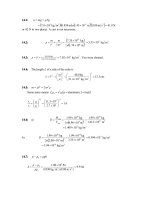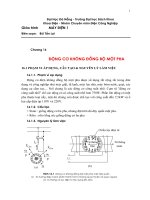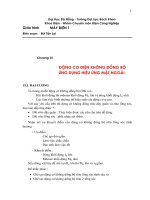Tài liệu Điện tử_ Chapter 14 docx
Bạn đang xem bản rút gọn của tài liệu. Xem và tải ngay bản đầy đủ của tài liệu tại đây (1.6 MB, 81 trang )
ELECTRICAL ENGINEERING: PRINCIPLES AND APPLICATIONS, Third Edition, by Allan R. Hambley, ©2005 Pearson Education, Inc.
Chapter 14
Operational Amplifiers
ELECTRICAL ENGINEERING: PRINCIPLES AND APPLICATIONS, Third Edition, by Allan R. Hambley, ©2005 Pearson Education, Inc.
Chapter 14
Operational Amplifiers
1. List the characteristics of ideal op amps.
2. Identify negative feedback in op-amp circuits.
3. Analyze ideal op-amp circuits that have negative
feedback using the summing-point constraint.
ELECTRICAL ENGINEERING: PRINCIPLES AND APPLICATIONS, Third Edition, by Allan R. Hambley, ©2005 Pearson Education, Inc.
4. Select op-amp circuit configurations
suitable
for various applications.
5. Design useful circuits using op amps.
6. Identify practical op-amp limitations
and
recognize potential inaccuracies in
instrumentation applications.
7. Work with instrumentation
amplifiers.
8. Apply integrators, differentiators,
and active
filters.
ELECTRICAL ENGINEERING: PRINCIPLES AND APPLICATIONS, Third Edition, by Allan R. Hambley, ©2005 Pearson Education, Inc.
IDEAL OPERATIONAL AMPLIFIERS
ELECTRICAL ENGINEERING: PRINCIPLES AND APPLICATIONS, Third Edition, by Allan R. Hambley, ©2005 Pearson Education, Inc.
The input signal of a differential
amplifier consists of a differential
component and a common-mode
component.
21
vvv
id
−=
( )
21cm
2
1
vvv
i
+=
ELECTRICAL ENGINEERING: PRINCIPLES AND APPLICATIONS, Third Edition, by Allan R. Hambley, ©2005 Pearson Education, Inc.
Characteristics of Ideal Op
Amps
Infinite gain for the differential input signal
Zero gain for the common-mode input signal
Infinite input impedances
Zero output impedance
Infinite bandwidth
ELECTRICAL ENGINEERING: PRINCIPLES AND APPLICATIONS, Third Edition, by Allan R. Hambley, ©2005 Pearson Education, Inc.
ELECTRICAL ENGINEERING: PRINCIPLES AND APPLICATIONS, Third Edition, by Allan R. Hambley, ©2005 Pearson Education, Inc.
ELECTRICAL ENGINEERING: PRINCIPLES AND APPLICATIONS, Third Edition, by Allan R. Hambley, ©2005 Pearson Education, Inc.
SUMMING-POINT
CONSTRAINT
Operational amplifiers are almost
always used with negative feedback, in
which part of the output signal is
returned to the input in opposition to
the source signal.
ELECTRICAL ENGINEERING: PRINCIPLES AND APPLICATIONS, Third Edition, by Allan R. Hambley, ©2005 Pearson Education, Inc.
In a negative feedback system, the ideal
op-amp
output voltage attains the value needed
to force
the differential input voltage and input
current to zero. We call this fact the
summing-point constraint.
ELECTRICAL ENGINEERING: PRINCIPLES AND APPLICATIONS, Third Edition, by Allan R. Hambley, ©2005 Pearson Education, Inc.
Ideal op-amp circuits are
analyzed by the following steps:
1. Verify that negative feedback is
present.
2. Assume that the differential input
voltage and the input current of the
op amp are forced to zero. (This is
the summing-point constraint.)
ELECTRICAL ENGINEERING: PRINCIPLES AND APPLICATIONS, Third Edition, by Allan R. Hambley, ©2005 Pearson Education, Inc.
3. Apply standard circuit-analysis
principles, such
as Kirchhoff’s laws and Ohm’s law, to
solve
for the quantities of interest.
ELECTRICAL ENGINEERING: PRINCIPLES AND APPLICATIONS, Third Edition, by Allan R. Hambley, ©2005 Pearson Education, Inc.
ELECTRICAL ENGINEERING: PRINCIPLES AND APPLICATIONS, Third Edition, by Allan R. Hambley, ©2005 Pearson Education, Inc.
ELECTRICAL ENGINEERING: PRINCIPLES AND APPLICATIONS, Third Edition, by Allan R. Hambley, ©2005 Pearson Education, Inc.
INVERTING AMPLIFIERS
1
2
in
R
R
v
v
A
o
v
−==
ELECTRICAL ENGINEERING: PRINCIPLES AND APPLICATIONS, Third Edition, by Allan R. Hambley, ©2005 Pearson Education, Inc.
ELECTRICAL ENGINEERING: PRINCIPLES AND APPLICATIONS, Third Edition, by Allan R. Hambley, ©2005 Pearson Education, Inc.
ELECTRICAL ENGINEERING: PRINCIPLES AND APPLICATIONS, Third Edition, by Allan R. Hambley, ©2005 Pearson Education, Inc.
ELECTRICAL ENGINEERING: PRINCIPLES AND APPLICATIONS, Third Edition, by Allan R. Hambley, ©2005 Pearson Education, Inc.
ELECTRICAL ENGINEERING: PRINCIPLES AND APPLICATIONS, Third Edition, by Allan R. Hambley, ©2005 Pearson Education, Inc.
ELECTRICAL ENGINEERING: PRINCIPLES AND APPLICATIONS, Third Edition, by Allan R. Hambley, ©2005 Pearson Education, Inc.
Positive Feedback
With positive
feedback, the op
amp’s input and
output voltages
increase in
magnitude until
the output voltage
reaches one of its
extremes.
ELECTRICAL ENGINEERING: PRINCIPLES AND APPLICATIONS, Third Edition, by Allan R. Hambley, ©2005 Pearson Education, Inc.
ELECTRICAL ENGINEERING: PRINCIPLES AND APPLICATIONS, Third Edition, by Allan R. Hambley, ©2005 Pearson Education, Inc.
NONINVERTING
AMPLIFIERS
Under the ideal-op-
amp
assumption, the
non- inverting
amplifier is an ideal
voltage amplifier
having infinite
input
resistance and zero
output resistance.
1
2
in
1
R
R
v
v
A
o
v
+==
ELECTRICAL ENGINEERING: PRINCIPLES AND APPLICATIONS, Third Edition, by Allan R. Hambley, ©2005 Pearson Education, Inc.
ELECTRICAL ENGINEERING: PRINCIPLES AND APPLICATIONS, Third Edition, by Allan R. Hambley, ©2005 Pearson Education, Inc.
Voltage Follower









